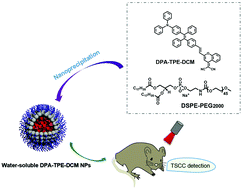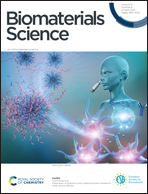Near-infrared aggregation-induced emission nanodots for early diagnosis of tongue squamous cell carcinoma and sentinel lymph node mapping†
Abstract
Fluorescence imaging has been widely used in the biomedical field owing to its merits of high sensitivity, excellent accuracy, high biosafety, etc. However, despite the good performance of fluorescent materials in the diagnosis of subcutaneous tumors or some orthotopic tumors in mice, their potential clinical application for most orthotopic tumors in humans is still limited due to their weak tissue penetration ability and the high thickness of human tissues. Given that the human tongue can extend out of the mouth and is approximately 1 cm thick, the diagnosis of tongue squamous cell carcinoma (TSCC) by fluorescence has great potential for clinical applications. However, to the best of our knowledge, a few studies have been performed to detect tongue tumors using fluorescence imaging, and most of them are administered in a subcutaneous tumor-bearing mouse model and are based on fluorescent materials with aggregation-caused quenching effects. Herein, by developing DPA-TPE-DCM with intense near-infrared fluorescence emission in the aggregation state, aggregation-induced emission materials were used for the first time in the early diagnosis of orthotopic TSCC and sentinel lymph node (SLN) mapping in an immunocompetent mouse model of orthotopic TSCC with a high signal-to-background ratio of 10.2. Moreover, with the guidance of the fluorescence of DPA-TPE-DCM NPs, SLNs smaller than 2 mm in diameter were successfully excised. This study provides new insight and a method for the early diagnosis of TSCC in clinical practice and provides more possibilities to broaden the potential clinical applications of fluorescent materials.

- This article is part of the themed collection: Biomaterials Science Recent HOT Articles


 Please wait while we load your content...
Please wait while we load your content...